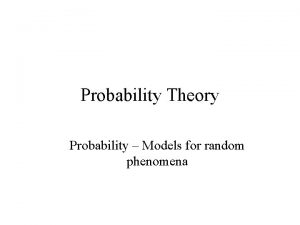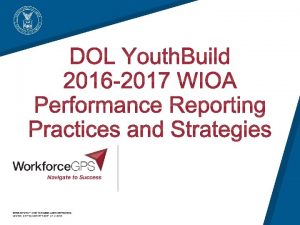Enter your location in the chat window lower






























































- Slides: 62

Enter your location in the chat window (lower left of screen) 1

May 22, 2019 Reemployment Service and Eligibility Assessment (RESEA) Evaluation Technical Assistance (Eval. TA)

Senior Program Analyst and RESEA Evaluation TA Coordinator Office of Policy Development and Research, ETA, U. S. DOL 3

Our previous webinar on May 2, 2019 provides an overview of the following topics: ØProgram evaluation and its benefits for RESEA programs; ØTools to help you form learning goals and think about your potential evaluation efforts; and ØKey evaluation concepts about research questions and evaluation designs. 4

Describe implementation and process studies and what you can learn from them; Discuss the concept of “impact” and how to measure it using control or comparison groups; and Provide an introduction to different impact evaluation designs. Today’s presentation provides mid-level of complexity of evaluation methods, terms, and approaches to consider. 5

Clarifies the program goals and strategies, Identifies relevant and useful research questions, Determines the approach type of evaluation, Identifies relevant data sources, and Describes data analysis plans that allow for valid conclusions to be made. ~ Designing Evaluations, GAO Applied Research and Methods, 2012 6

Pre • Needs assessment evaluation • Literature reviews Assessment Descriptive Impact • Implementation studies • Process studies • Random assignment • Quasi-experimental design (QED) 7

Question • What really happens in our RESEA program? How to Answer It • Implementation and Process Study • Does our RESEA program improve outcomes? Would an alternative strategy yield even better outcomes? • Impact Study • Strongest Approach: Random assignment • Quasi-experimental designs (QEDs) • DOL and Abt are here to help! • How are we going to do this? 8

Senior Associate Abt Associates Senior Analyst Abt Associates 9

Question How to Answer It • What really happens in our • Implementation and RESEA program? Process Study • Does our RESEA program • Impact Study improve outcomes? • Strongest Approach: Would some alternative Random Assignment strategy yield even better • Quasi-experimental outcomes? designs (QEDs) • How are we going to do this? • DOL and Abt are here to help! 10

¡Identify how closely program implementation adheres to plans, } Including the variations that exist across locations (Workforce Development Boards and Regions, American Job Centers, etc. ) ¡Explain “what is happening and why” to help understand what claimants’ experiences are and to support quick feedback in areas to improve quality or efficiency. 11

¡Provide feedback to program managers, and accountability to program sponsors and the public ¡Highlight best practices and identify areas that can be strengthened ¡Inform future program development or support replication ¡Help interpret impact study findings 12

¡Identify research questions of interest ¡Systematically collect data through: } Interviews with staff, claimants, and stakeholders, } Focus groups with participants } Review of program documents } Observation of program activities } Administrative or survey data ¡Analyze themes in data using qualitative research methods ¡Summarize and communicate findings 13

¡Researchers may have to make judgments about what certain types qualitative and/or subjective data are telling them ¡Cannot tell you whether your intervention causes changes in claimant outcomes ~Werner, A. (2012). Guide to Implementation Research. Urban Institute Press 14

Question • What really happens in our RESEA program? How to Answer It • Implementation and Process Study • Does our RESEA program improve outcomes? Would some alternative strategy yield even better outcomes? • Impact Study • Strongest Approach: Random assignment • Quasi-experimental designs (QED) • DOL and Abt are here to help! • How are we going to do this?

¡What do we mean by “impact”? ¡What should I consider when choosing a method to estimate impact? 1. Credibility: Can the design give me valid results? 2. Sample Size: How large of a sample of claimants do we need to detect differences in the outcomes of interest? 3. Logistics: What is involved in executing the evaluation design? 16

¡What do we mean by “impact”? ¡What should I consider when choosing a method to estimate impact? 1. Credibility: Can the design give me valid results? 2. Sample Size: How large of a sample of claimants do we need to detect differences in the outcomes of interest? 3. Logistics: What is involved in executing the evaluation design? 17

Treatment Outcomes w/ intervention vs. Counterfactual Outcomes w/o intervention Holding all else equal 18

Treatment Outcomes w/ intervention vs. Counterfactual Outcomes w/o intervention Holding all else equal ¡The impact of the RESEA intervention is defined as … ¡… the difference between outcomes with the RESEA intervention vs. outcomes w/o the RESEA intervention 19

Treatment Outcomes w/ intervention vs. Counterfactual Outcomes w/o intervention Holding all else equal ¡The impact of the RESEA intervention is defined as … ¡… the difference between outcomes with the RESEA intervention vs. outcomes w/o the RESEA intervention ¡… holding all else equal 20

1. Does my RESEA program “make a difference”? 2. Does a component of my RESEA program “make a difference”? 3. Would an alternative strategy “make a bigger difference”? 21

1. Does my RESEA program “make a difference”? 2. Does a component of my RESEA program “make a difference”? } Are outcomes better than they would be if the claimant had not been assigned to the program? } How large is the difference? 3. Would an alternative strategy “make a bigger difference”? 22

1. Does my RESEA program “make a difference”? 2. Does a component of my RESEA program “make a difference”? 3. Would an alternative strategy “make a bigger difference”? } E. g, Do intensive reemployment services received by claimants contribute to RESEA program impacts? } How much of a difference do they make? 23

1. Does my RESEA program “make a difference”? 2. Does a component of my RESEA program “make a difference”? 3. Would an alternative strategy “make a bigger difference”? } E. g. , Would using different needs assessments change employment outcomes? } Which way (better or worse)? } How large a difference? 24

Reemployment Rate: Claimants Selected for RESEA 80% 70% 60% 50% 40% 30% 20% 10% 0% Actual Rate (Observed) What the Rate Would have been if not Selected for RESEA (not observed) 25

Reemployment Rate: Claimants Selected for RESEA 80% 70% 60% 50% 40% 30% 20% 10% 0% Actual Rate (Observed) What the Rate Would Have Been if not Selected for RESEA (not observed) 26

Reemployment Rate: Claimants Selected for RESEA 80% 70% Impact 60% 50% 40% 30% 20% 10% 0% Actual Rate (Observed) What the Rate Would Have Been if not Selected for RESEA (not observed) 27

¡What do we mean by “impact”? ¡What should I consider when choosing a method to estimate impact? 1. Credibility: Can the design give me valid results? 2. Sample Size: How large of a sample of claimants do we need to detect differences in the outcomes of interest? 3. Logistics: What practical concerns do I need to address to execute an evaluation of this type? 28

¡What do we mean by “impact”? ¡What should I consider when choosing a method to estimate impact? 1. Credibility: Can the design give me valid results? 2. Sample Size: How large of a sample of claimants do we need to detect differences in the outcomes of interest? 3. Logistics: What practical concerns do I need to address to execute an evaluation of this type? 29

Treatment Outcomes w/ intervention vs. Counterfactual Outcomes w/o intervention Holding all else equal ¡We only see what happens under one condition, not the other, so the challenge is: } How do we know what would have happened otherwise? ¡Impact evaluations aim to solve that challenge 30

¡We want our study to estimate “impact” } Do the results reflect only the effects of the intervention, not other factors? ¡To estimate impact we need a good counterfactual } A comparison source that shows us what outcomes our treatment group would have had if they had not received the treatment. ¡What might that be? 31

¡Can a state get an accurate estimate of the impact of its RESEA program by comparing: 1) The outcomes of RESEA claimants to 2) The outcomes of claimants not selected for RESEA? 32

¡Example: Comparing RESEA claimants to claimants not selected for RESEA Reemployment Rate 80% 70% 60% 50% 40% 30% We want these two bars to be the same 20% 10% 0% RESEA Claimants' What RESEA Non-RESEA Actual Rate Claimants' Rate Would. Claimants' Actual Rate (Observed) Have Been if not (Observed) Selected (not observed) 33

¡Example: Comparing RESEA claimants to claimants not selected for RESEA Reemployment Rate 80% 70% 60% 50% 40% 30% We want these two bars to be the same 20% 10% 0% RESEA Claimants' What RESEA Non-RESEA Actual Rate Claimants' Rate Would. Claimants' Actual Rate (Observed) Have Been if not (Observed) Selected (not observed) 34

¡Example: Comparing RESEA claimants to claimants not selected for RESEA Reemployment Rate 80% 70% 60% True Impact Estimated Impact 50% 40% 30% 20% 10% 0% RESEA Claimants' What RESEA Non-RESEA Actual Rate Claimants' Rate Would. Claimants' Actual Rate (Observed) Have Been if not (Observed) Selected (not observed) 35

¡Can a state get an accurate estimate of the impact of its RESEA program by comparing: } The outcomes of RESEA claimants to } The outcomes of claimants not selected for RESEA? ¡NO! } Because all else is not equal 36

¡Through CLEAR, DOL has established standards for whether a study has established a credible counterfactual (https: //clear. dol. gov/) } CLEAR’s ratings indicate how confident we can be that a study’s findings reflect the impact of an intervention, rather than something else } You will want your impact evaluations to meet CLEAR standards ¡CLEAR has standards for different designs } Random assignment (experimental) } Other designs (quasi-experimental) 37

For each person, flip a coin Which is random …

For each person, flip a coin Heads … Get the intervention Only (systematic) difference between the groups is the intervention Tails … Do not get the intervention Which is random … i. e. , random assignment “holds all else equal”

For each person, flip a coin Heads … Get the intervention Only (systematic) difference between the groups is the intervention Tails … Do not get the intervention Which is random … So any difference in outcomes must be due to the program

Question • What really happens in our RESEA program? Strategy • Implementation and Process Study • Does our RESEA program improve outcomes? Would some alternative strategy yield even better outcomes? • Impact Study • Strongest Approach: Random Assignment • Quasi-experimental designs (QED) • DOL and Abt are here to help! • How are we going to do this? 41

¡Find people who did not receive the intervention who look like those who did in all observable ways Blue: Selected for Intervention Red: Not Selected for Intervention 42

¡Find people who did not receive the intervention who look like those who did in all observable ways Blue: Selected for Intervention Red: Not Selected for Intervention 43

¡Find people who did not receive the intervention who look like those who did in all observable ways Blue: Received the Intervention Red: Did Not Receive the Intervention 44

¡Limitations: } There may be few or no comparison claimants that really are similar on observables to intervention claimants } There may be large differences on unobserved characteristics that we cannot account for 45

¡What do we mean by “impact”? ¡What should I consider when choosing a method to estimate impact? 1. Credibility: Can the design give me valid results? 2. Sample Size: How large of a sample of claimants do we need to detect differences in the outcomes of interest? 3. Logistics: What is involved in executing the design? 46

¡Example of a very small sample } Sample of 3 comparison group members and 3 treatment group members. } Suppose ê 66. 7% (2 of 3) of comparison group members get a job ê 33. 3% (1 of 3) of treatment group members get a job êDid the program have an impact of -33%? ¡Small sample sizes lead to inconclusive results ¡But how large of a sample do you need? 47

¡Required sample sizes are often surprisingly large ¡Sample sizes needed depends on: } Outcomes of interest } How large the difference is between the RESEA intervention and the counterfactual intervention } Study design 48

¡Likely Minimum Sample Sizes, by Outcome } Intermediate outcomes: Hundreds of claimants } UI outcomes: Thousands of claimants } Labor market outcomes: Tens of thousands of claimants ¡Statute requires evidence of impact on UI outcomes and labor market outcomes ¡Sample sizes for QEDs are larger, sometime much larger than for random assignment designs 49

¡What do we mean by “impact”? ¡What should I consider when choosing a method to estimate impact? 1. Credibility: Can the design give me valid results? 2. Sample Size: How large of a sample of claimants do we need to detect differences in the outcomes of interest? 3. Logistics: What is involved in executing the evaluation design? 50

¡Possible changes to program implementation ¡Time required to conduct evaluation ¡Technical expertise ¡IT and data resources 51

¡Possible changes to program implementation ¡Time required to conduct evaluation ¡Technical expertise } More intense when testing alternative services } May need to train staff on new procedures } RCTs may require more oversight if service provision has to be monitored ¡IT and data resources 52

¡Possible changes to program implementation ¡Time required to conduct evaluation ¡Technical expertise } If you can use existing data it will take less time êPossible only with QEDs } If you have to gather new data, it will require more time êRCTs êAny tests of new interventions ¡IT and data resources 53

¡Possible changes to program implementation ¡Time required to conduct evaluation ¡Technical expertise } Substantial expertise is required to successfully implement any high quality impact evaluation } QEDs are more technically complex than random assignment to carry out ¡IT and data resources 54

¡Possible changes to program implementation ¡Time required to conduct evaluation ¡Technical expertise } Identify sources of all needed measures, and assess data quality } QEDs: Require a richer set of background characteristics } Random assignment: Incorporate random assignment into RESEA selection algorithms ¡IT and data resources 55

Question • What really happens in our RESEA program? How to Answer It • Implementation and Process Study • Does our RESEA program improve outcomes? Would some alternative strategy yield even better outcomes? • How are we going to do this? • Impact Study • Randomized Trial (the leading design) • Other designs • DOL and Abt are here to help! 56

¡Look for the RESEA webinar series schedule with more evaluation topics ¡Expect an RESEA-specific evaluation toolkit as well as a series of briefs ¡Ask for one-on-one customized Eval. TA } Walks you systematically through needed planning steps and provides feedback on ideas } Contact RESEA@abtassoc. com for more information 57

What Evaluation Details Do I Need for a Plan and How Long Will It Take? Week of June 17 -21, 2019 Procuring and Selecting an Independent Evaluator Week of July 15 -19, 2019 Using CLEAR – A Demonstration Week of August 5 -9, 2019 58

Lawrence Burns Reemployment Coordinator Office of Unemployment Insurance Megan Lizik Senior Evaluation Specialist and Project Officer for RESEA Evaluation Chief Evaluation Office Wayne Gordon Director Division of Research and Evaluation 59

Enter your questions in the chat window (lower left of screen) 60

Reemployment Coordinator U. S. DOL – Office of Unemployment Insurance Burns. Lawrence@dol. gov 202 -693 -3141 Senior Evaluation Specialist and Project Officer U. S. DOL – Chief Evaluation Office Lizik. Megan@dol. gov Evaluation Technical Assistance Coordinator U. S. DOL – Office of Policy Development and Research RESEA@abtassoc. com Senior Analyst Abt Associates Tresa_Kappil@abtassoc. com 301. 347. 5923 Salas-Kos. Gloria@dol. gov Senior Associate Abt Associates Andrew_Clarkwest@abtassoc. com 301. 347. 5065

62
 ưu trương
ưu trương Ang mahahalagang salita sa pamagat ay nagsisimula sa
Ang mahahalagang salita sa pamagat ay nagsisimula sa Window width ct
Window width ct Window to window mbti
Window to window mbti Windows vista inside out
Windows vista inside out Window to window chapter 28
Window to window chapter 28 Carotid cana
Carotid cana Oval window and round window
Oval window and round window Window to window chapter 19
Window to window chapter 19 Please enter your username
Please enter your username Enter your state name
Enter your state name 1 enter your email
1 enter your email 1 enter your email
1 enter your email Mail @ slidetodoc.com
Mail @ slidetodoc.com 1 enter your email
1 enter your email 1 enter your email
1 enter your email Type your title here
Type your title here Independent probability formula
Independent probability formula Company name (optional)
Company name (optional) Augoral
Augoral Type your answer in the chat box
Type your answer in the chat box A cross country skier moves from location a
A cross country skier moves from location a Location planning in operations management
Location planning in operations management Lower your gaze quran
Lower your gaze quran Non mahram meaning
Non mahram meaning Give us your hungry your tired your poor
Give us your hungry your tired your poor Hình ảnh bộ gõ cơ thể búng tay
Hình ảnh bộ gõ cơ thể búng tay Frameset trong html5
Frameset trong html5 Bổ thể
Bổ thể Tỉ lệ cơ thể trẻ em
Tỉ lệ cơ thể trẻ em Gấu đi như thế nào
Gấu đi như thế nào Tư thế worm breton
Tư thế worm breton Hát lên người ơi
Hát lên người ơi Các môn thể thao bắt đầu bằng tiếng chạy
Các môn thể thao bắt đầu bằng tiếng chạy Thế nào là hệ số cao nhất
Thế nào là hệ số cao nhất Các châu lục và đại dương trên thế giới
Các châu lục và đại dương trên thế giới Cong thức tính động năng
Cong thức tính động năng Trời xanh đây là của chúng ta thể thơ
Trời xanh đây là của chúng ta thể thơ Mật thư tọa độ 5x5
Mật thư tọa độ 5x5 101012 bằng
101012 bằng độ dài liên kết
độ dài liên kết Các châu lục và đại dương trên thế giới
Các châu lục và đại dương trên thế giới Thể thơ truyền thống
Thể thơ truyền thống Quá trình desamine hóa có thể tạo ra
Quá trình desamine hóa có thể tạo ra Một số thể thơ truyền thống
Một số thể thơ truyền thống Bàn tay mà dây bẩn
Bàn tay mà dây bẩn Vẽ hình chiếu vuông góc của vật thể sau
Vẽ hình chiếu vuông góc của vật thể sau Nguyên nhân của sự mỏi cơ sinh 8
Nguyên nhân của sự mỏi cơ sinh 8 đặc điểm cơ thể của người tối cổ
đặc điểm cơ thể của người tối cổ V. c c
V. c c Vẽ hình chiếu đứng bằng cạnh của vật thể
Vẽ hình chiếu đứng bằng cạnh của vật thể Fecboak
Fecboak Thẻ vin
Thẻ vin đại từ thay thế
đại từ thay thế điện thế nghỉ
điện thế nghỉ Tư thế ngồi viết
Tư thế ngồi viết Diễn thế sinh thái là
Diễn thế sinh thái là Dạng đột biến một nhiễm là
Dạng đột biến một nhiễm là Số nguyên là gì
Số nguyên là gì Tư thế ngồi viết
Tư thế ngồi viết Lời thề hippocrates
Lời thề hippocrates Thiếu nhi thế giới liên hoan
Thiếu nhi thế giới liên hoan ưu thế lai là gì
ưu thế lai là gì






















































































